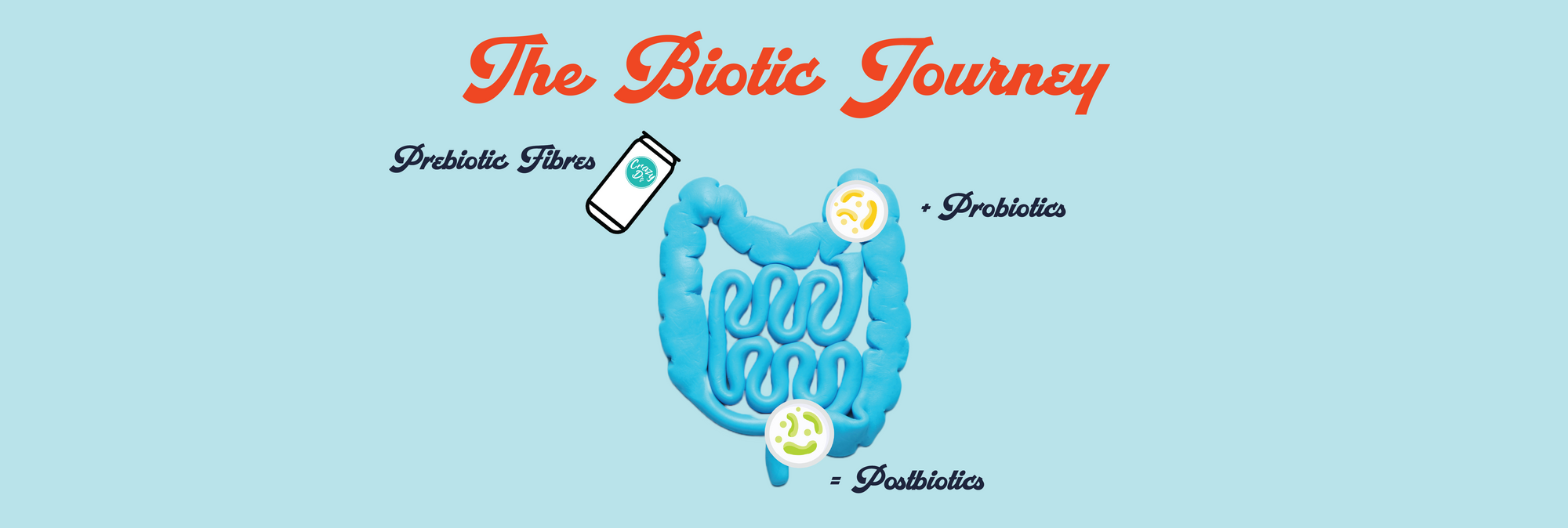

· By Crazy D's Sparkling Prebiotic
The Role of Prebiotics Throughout the Biotic Journey
Reading Time: 5 min
Ladies and gentlemen welcome to this illuminating tour of the biotic journey!
We're so glad you've gone with your gut and decided to join us on this exciting exploration of prebiotics and their impact on your microbiome.
We'll be your travel guide, bringing you exclusive, behind-the-scenes access to the gastrointestinal (GI) tract and up close and personal with the microbial process.
Please remain seated throughout the tour and no flash photography.
What Happens During the Biotic Journey
Our first stop on this expedition is scientific research.
It’s here that you’ll discover the profound connections experts have made between gut health and overall wellness that have definitively proven the importance of supporting and maintaining a balanced microbiome.
Studies have revealed that gut homeostasis relies on bacterial diversity. Fortunately, our gut is already home to trillions (Yes you read that right, approximately 100 trillion), of natural and healthy bacteria belonging to thousands of different species.
Research shows that nourishing these beneficial species can boost immune function, mental wellness, focus and nutrient absorption while reducing inflammation, cholesterol and fatigue.
The Biotic Trifecta
There are three key players in the nutritional exchange between our gut and bodies, each relying on the other in a symbiotic relationship.
These players include:
1. PREBIOTICS
Prebiotics are a form of non-digestible soluble fibre that human cells cannot digest. They are the 'fertilizer' or 'food' that nurtures essential good bacteria in the gut by selectively stimulating the growth of desirable microorganisms (probiotics) while simultaneously reducing or maintaining pathogenic bacteria populations.

2. PROBIOTICS
Probiotics are live microorganisms that naturally inhabit the gut and provide various health benefits. They are the "good" or "friendly" bacteria that bodies need (Most commonly Lactobacillus and Bifidobacterium).
3. POSTBIOTICS
Postbiotics are abiotic materials that result from the probiotic fermentation of prebiotic fibre. Postbiotics are a useful chemical byproduct in the functioning of an overall healthy gut.
Early Gut Health Development
Just like every great superhero, our gut has an origin story and it’s here that gut health begins to take shape.
When babies are born, they are without any microorganisms, and only when they pass through the birth canal and then begin nursing, do they become hosts to an array of healthy bacteria within the gut. The soluble, prebiotic fibre found in breast milk kickstarts the development of the microbiome and postbiotic production.
From birth, humans are in a mutually beneficial and codependent relationship with their gut bacteria as it profoundly affects immunity to diseases, energy levels, liver function, digestive health, cardiovascular wellness and mental health.
Gut Health Maintenance - Where Prebiotic Fibre and Probiotics Converge!
Many people wonder, can you take prebiotics and probiotics together? Maintaining proper gut health means finding a lifestyle and dietary balance that incorporates consuming prebiotics and probiotics either through foods or supplements.

One of the most important factors in nurturing a healthy microbiome is consuming enough fibre to support gut function. The recommended daily amount is 25 g for women and 38 g for men. Studies show that few actually achieve the appropriate daily intake (Particularly men, who average approximately 40% of daily recommendations while women average 60%).
Prebiotic fibre passes through the small intestine undigested, reaching the large intestine which is the home of our gut flora. Here it feeds, strengthens and multiplies some of the trillions of probiotic cells in the body's digestive tract and begins the process of *fermentation.
This fermentation process occurs in the large intestine and helps feed and strengthen beneficial bacteria colonies (Including probiotic bacteria that produce gut-healing postbiotics), thereby maintaining a balanced gut and aiding your immune system.
When our bodies lack enough prebiotics, probiotic bacteria seek fuel from other sources and often resort to eating the gut's mucous layer, exposing our intestines to harmful germs.
Sources of Prebiotic Fibres
Crazy D’s Sparkling Prebiotic Sodas are an excellent source of a variety of prebiotic fibres recommended for healthy gut function as each soda contains 3 different types of naturally occurring prebiotics from natural sources including Yacon Root, Chicory Root, Acacia Fibre (Sap from the Acacia Tree) and Baobab Fruit Pulp.

What are the Benefits of Postbiotics
We've now arrived at the last stage of the biotic process; postbiotics! Postbiotics are responsible for many of the gut-healing benefits attributed to microbiota.
Postbiotic compounds include amino acids, peptides, short-chain fatty acids, enzymes and hydrogen peroxide. These byproducts have specific health-boosting functions in the gut, such as:
Lowering blood sugar and preventing obesity by relieving glucose intolerance and increasing insulin sensitivity with a postbiotic compound called muramyl dipeptide.
Shielding against harmful bacteria by acting as placeholders in areas desirable for bad bacteria, namely pathogens.
Reducing inflammation by supporting the intestinal environment, cell barrier and expression of protective genes with several anti-infectious agents, notably reducing infection symptoms relating to diarrhea, IBS, and salmonella poisoning.
Supporting immunity by acting as a more tolerable remedy to inflammation in patients with immunodeficiency, compared to probiotic supplements.
How to Achieve Balance in Your Gut

Your microbiota must be nourished and abundant in diversity to produce the chemical compounds essential to life. To help steer you in the right direction, we suggest feeding and taking care of your existing probiotic bacteria with a good variety of prebiotic fibres, which in turn will naturally create postbiotics.
Crazy D's Sparkling Prebiotic Sodas are a delicious and easy way to incorporate a great source of prebiotic fibre into your diet. Each beverage contains a variety of prebiotics from quality ingredients like Yacon Root, Chicory Root, Acacia Fibre and Baobab Fruit Pulp in delicious recipes that are designed for optimal gut health. Get them here!
We hope you've enjoyed your time with us on this tour discovering the fascinating biotic relationship and the means to maintain gut homeostasis and a healthy microbiome.
After all, what is life without a little (Or a lot of), beneficial bacteria?
Resources
https://www.brightlifeclinic.com/what-are-postbiotics-5-health-benefits/
https://pubmed.ncbi.nlm.nih.gov/32717965/
https://www.ncbi.nlm.nih.gov/pmc/articles/PMC5390821/#:~:text=
Dietary%20fibers%2C%20carbohydrate%20polymers%20which,pr
- #acacia fibre
- #bacteria
- #baobab
- #Biotic Journey
- #bioticjourney
- #chicory root
- #digestion
- #digestive health
- #digestive tract
- #fibre
- #functional beverage
- #functional soda
- #gut
- #gut health
- #immune system
- #large intestine
- #microbiome
- #microbiota
- #postbiotic
- #prebiotic
- #prebiotic drink
- #prebiotic soda
- #prebioticsfoods
- #probiotic
- #soda
- #wellness
- #yacon root
- #zero plastic
